Rio Monterroso
The Monterroso River (Rio Monterroso or Arroyo Monterroso) is a seasonal river that flows from the Sierra Bermeja mountains to Estepona, Andalusia, Spain, where it empties into the Mediterranean Sea.[1] It stays dry through the summer as its flow during the winter rainy season depends on the amount of rain.
The river was originally culverted on the coast of Estepona in the 1960s.[2] However a much larger culvert was constructed in January 12, 1973 [3] and runs underground in the city of Estepona, beginning at Calle Monterroso.[4]
The culvert is located directly under Av. Juan Carlos I, the main road in Estepona.[5] The outfall of the culvert is located on the southern end of the Av. Juan Carlos I. The river culvert was constructed to form the Av. Juan Carlos I. The culvert is 1.16 km in length, has a span of 36 feet (11 metres) and a rise of 8'6" (2.61m).[6] In the early days of Estepona, growth of the city was restricted by 2 rivers, River monterroso and river calancha. Eventually resulting in them being culverted in the late 1930s and early 1970s. The newer culverting of the Monterroso river formed the Av. Juan Carlos I.[2]
In January 12, 1973 the dossiers were signed to construct the river Monterroso culvert. The construction of the River Monterroso culvert had a budget of ₽55,105,234 (€5,914,191) (USD$7,072,952) however, the predicted price in March 29 was ₽51.247.869 (€5,500,184) (USD$6,577,972).[7]
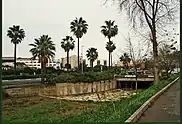

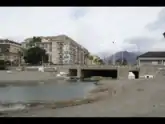
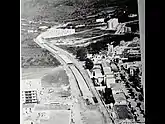
On October 11, 1986 the original separate 1960s culvert that the river Monterroso usually flowed through via the newer culvert had collapsed.[8] This engulfed a sewage treatment truck. The operator managed to get out in time. This created a 700 square metre sinkhole and sparked the construction of the rest of the culvert to engulf the original location of the collapsed bridge maintaining the shape and size of the original box culvert in 1987.


As of 2015, there were plans to build a river park along the banks of a portion of the Monterroso river in Estepona.[9]
In 2017 the plans to build the river park was not undergone due to the lack of authorisation; however, a beautification project was said to be carried out.[10]
Inside the River Monterroso culvert, the arroyo de Juan Benítez flows in via another culvert which is also over a kilometer in length,[11] in 2018 plans to resize a portion of the culvert were undergone successfully.[12][13]
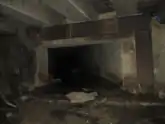
The resizing was carried out by constructions y excavations manzano[14] and costed 5 million euros ($6mil) to carry out
The original River Monterroso culvert
In April 1965, the Monterroso River was originally only culverted on the coastline and was approximately 45 metres (147 feet) long. The culvert was originally budgeted at 294,053.93 Pesetas (€36,095.59 in 2020+ inflation) however the finish price costed 9,828,431.02 Pesetas (€1,208,295.35 in 2020+ inflation)
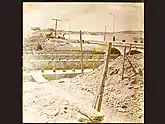

Like the original River Monterroso Culvert, most Spanish culverts from that era featured a vaulted ceiling, which is most likely where the name "Embovedado" comes from when associated with culverts in Spain.
Drainage
Inside the river monterroso culvert there are storm drains and sewers[15] connected That outfall into the culvert system via pipes. They Can be different shapes and size pipes. They range from 5 inches to 4 feet in size. And There are over 500 outlet pipes that flow into the monterroso culvert.[16]

However the most common seems to be 7 inch concrete cutouts in the wall that was created when the culvert was first constructed.

References
- Marzo, Ildefonso (1853). Historia de Malaga y su provincia [History of Malaga and its province] (in Spanish). 3 (2nd ed.). Rosal. p. 67.
- Aqua Nostra, agua de todos : el agua en la costa occidental malagueña. Marbella: Asociación Cilniana para la Defensa y Difusión del Patrimonio Cultural de la Costa del Sol. 2005. p. 122. ISBN 8-4609-3637-6. OCLC 629799130.
- "Vistas de ayer y hoy: Avenida de España/Río Monterroso, Estepona, Málaga". September 9, 2011.
- "Calle Monterroso". Google Maps. Retrieved 2020-11-03.
- "Estepona amanece inundada y el Ayuntamiento activa el plan de Emergencia Municipal". Diario Sur (in Spanish). 2016-12-04. Retrieved 2020-11-03.
- "Measurement from Calle Monterroso to bottom of Av. Juan Carlos I". Google Maps. Retrieved 2020-11-03.
- https://boe.es/boe/dias/1973/03/29/pdfs/A06230-06248.pdf
- "Lluvia torrencial en Estepona". El País (in Spanish). 1986-10-12. ISSN 1134-6582. Retrieved 2020-11-03.
- "Estepona proyecta un parque fluvial en el arroyo Monterroso". www.europapress.es. 2015-03-26. Retrieved 2020-11-03.
- "El Ayuntamiento trabaja en el Parque Fluvial del Río Monterroso".
- "36°26'02.8"N 5°09'16.7"W". 36°26'02.8"N 5°09'16.7"W.
- https://www.youtube.com/watch?v=IdrA71lsfTU&feature=youtu.be
- "El Ayuntamiento de Estepona impulsa obras de urbanización valoradas en 30 millones". La Vanguardia. November 28, 2016.
- https://www.facebook.com/contruccionesyexcavacionesmanzano/
- Some pipes clearly dump wastewater as there is a chemical smell coming from them and the water they pour is greyish dark or blue in colour.
- amount counted when walking through the culvert
